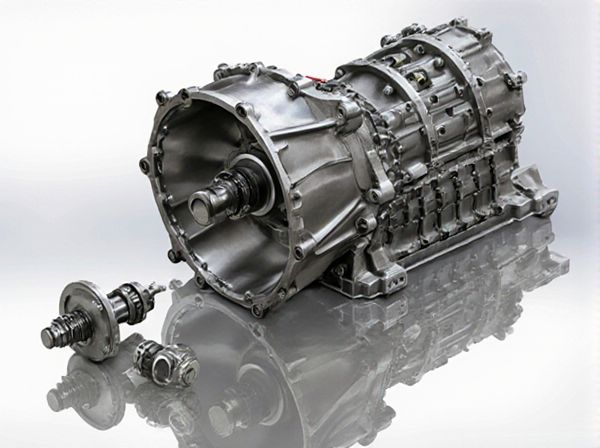
Photo illustration: Overdrive vs Underdrive
Overdrive increases your vehicle's transmission gear ratio, allowing the engine to run at lower RPMs during high speeds, which improves fuel efficiency and reduces engine wear. Underdrive, in contrast, decreases the gear ratio, causing the engine to run at higher RPMs for increased power and acceleration, often used for towing or off-road performance. Choosing between overdrive and underdrive depends on your driving needs, whether prioritizing fuel economy or enhanced power.
Table of Comparison
| Feature | Overdrive | Underdrive |
|---|---|---|
| Definition | Gear ratio where output speed exceeds input speed | Gear ratio where output speed is lower than input speed |
| Purpose | Improves fuel efficiency at high speeds | Increases torque for acceleration and towing |
| Common Use | Highway cruising in automatic/manual transmissions | Starting from stop, climbing hills, heavy load conditions |
| Effect on RPM | Reduces engine RPM relative to road speed | Increases engine RPM for more power |
| Fuel Efficiency | Enhances fuel economy | Consumes more fuel due to higher engine load |
| Impact on Engine | Lower engine strain, cooler operation | Higher engine strain, increased wear possible |
Introduction to Overdrive and Underdrive
Overdrive refers to a gearing mechanism in vehicles that allows the engine to operate at a lower RPM while maintaining higher speeds, improving fuel efficiency and reducing engine wear. Underdrive, by contrast, reduces the speed of a driven component relative to the engine, increasing torque for better performance in specific applications like towing or racing. Understanding the differences between overdrive and underdrive gears is crucial for optimizing vehicle performance and efficiency according to driving conditions.
Definition of Overdrive
Overdrive is a gear mechanism in vehicles that allows the engine to operate at a lower RPM while maintaining higher speeds, improving fuel efficiency and reducing engine wear. It typically involves a gear ratio of less than 1:1, meaning the output speed exceeds the engine speed. Overdrive contrasts with underdrive, which increases engine RPM relative to output speed for greater torque and acceleration.
Definition of Underdrive
Underdrive refers to a mechanical setup where the drive pulley is smaller than the driven pulley, causing the driven component to rotate slower than the drive source. This configuration is commonly used to reduce speed while increasing torque and is often applied in automotive accessory drives to minimize engine load. Understanding underdrive pulleys is crucial for optimizing power transmission efficiency and achieving desired performance characteristics.
Key Differences Between Overdrive and Underdrive
Overdrive refers to a gear ratio in a vehicle where the output speed is higher than the input speed, typically reducing engine RPM for improved fuel efficiency and lower noise at high speeds. Underdrive, conversely, features a gear ratio where the output speed is lower than the input speed, often used to increase torque and acceleration by allowing the engine to operate at higher RPMs. Key differences lie in their functional purposes: overdrive enhances cruising efficiency, while underdrive boosts power delivery and performance in demanding driving conditions.
How Overdrive Works
Overdrive works by using a gear ratio that allows the output shaft to spin faster than the input shaft, reducing engine RPM at higher speeds for improved fuel efficiency and reduced engine wear. It engages a specific gear set in the transmission, typically with a ratio less than 1:1, which effectively decreases engine load and enhances cruising performance. This mechanism is commonly found in automatic and manual transmissions aimed at optimizing highway driving.
How Underdrive Works
Underdrive pulleys reduce the rotational speed of accessories like the alternator or power steering pump by having a smaller diameter than the crank pulley, allowing more engine power to be focused on the crankshaft. This slower accessory speed decreases parasitic drag, improving horsepower and torque output, especially at higher RPMs. By optimizing accessory load, underdrive setups enhance overall engine efficiency and responsiveness.
Benefits of Using Overdrive
Overdrive gears reduce engine RPM at higher speeds, improving fuel efficiency and lessening engine wear during long highway drives. By lowering rotational stress, overdrive enhances vehicle performance and reduces noise levels compared to underdrive systems. This results in smoother acceleration and better overall drivability while maintaining optimal power output when needed.
Advantages of Underdrive Systems
Underdrive systems reduce engine RPM, leading to improved fuel efficiency and lower wear on engine components by decreasing rotational speed during operation. They often provide enhanced torque at lower speeds, which benefits applications requiring smooth power delivery and better control. Additionally, underdrive pulleys can decrease parasitic losses, allowing auxiliary components like alternators and water pumps to operate more efficiently.
Overdrive vs Underdrive: Application Scenarios
Overdrive gears are primarily used in highway driving to reduce engine RPM, enhance fuel efficiency, and lower noise levels during steady cruising. Underdrive gears find application in towing, off-road, and heavy-load scenarios where increased torque and power delivery at lower speeds are essential for better control and performance. Selecting between overdrive and underdrive depends on the vehicle's operational needs, emphasizing fuel economy versus torque output in specific driving conditions.
Choosing the Right Option for Your Vehicle
Choosing the right option between overdrive and underdrive depends on your vehicle's purpose and performance requirements. Overdrive gears are ideal for fuel efficiency and lower engine RPMs during highway driving, reducing wear and improving mileage. Underdrive pulleys increase engine torque and power by slowing accessory speeds, making them suitable for performance enthusiasts seeking enhanced acceleration and throttle response.
 caratoz.com
caratoz.com